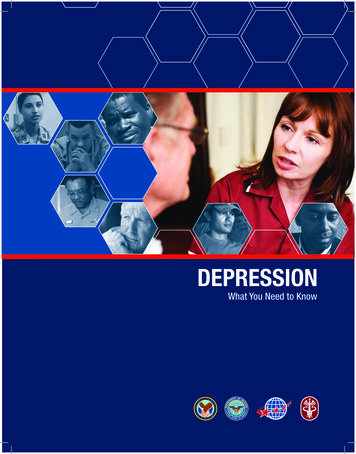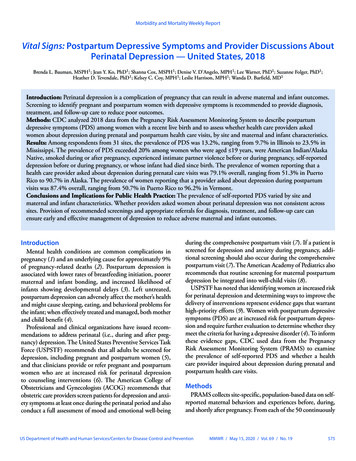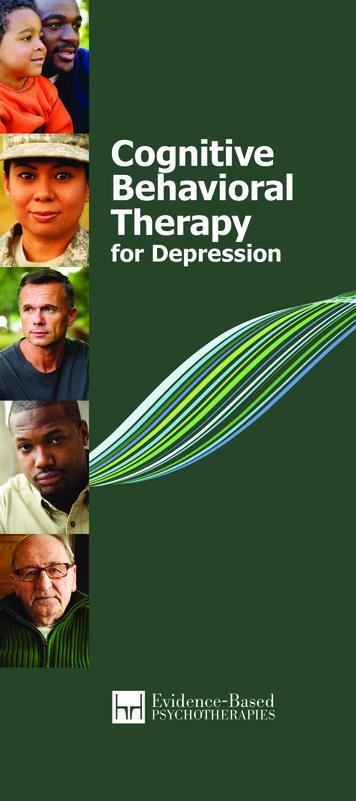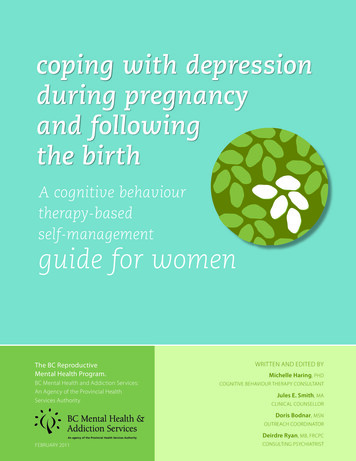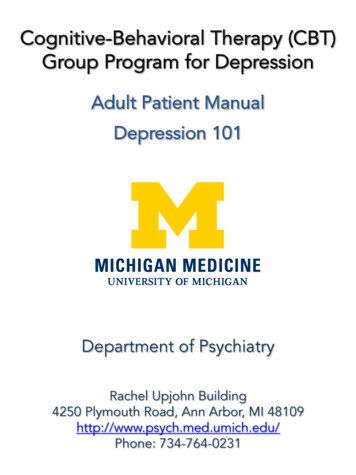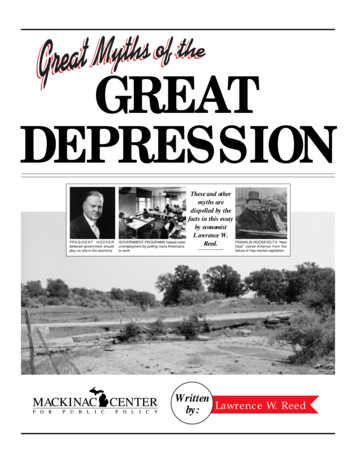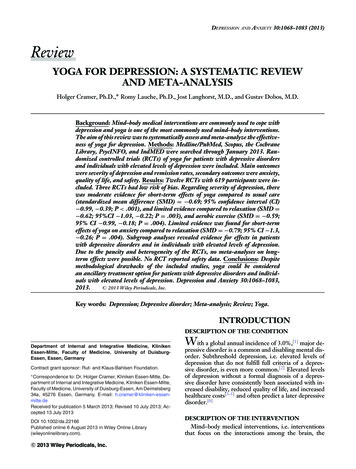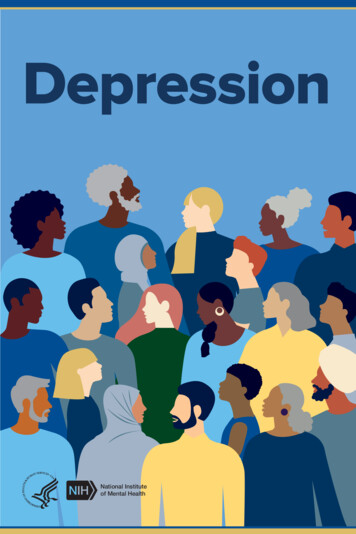
Transcription
Comparative Effectiveness ReviewNumber 62Treatment forDepression AfterUnsatisfactoryResponse to SSRIs
Comparative Effectiveness ReviewNumber 62Treatment for Depression After UnsatisfactoryResponse to SSRIsPrepared for:Agency for Healthcare Research and QualityU.S. Department of Health and Human Services540 Gaither RoadRockville, MD 20850www.ahrq.govContract No. 290-2007-10060-IPrepared by:McMaster University Evidence-based Practice CenterHamilton, ON, CanadaInvestigators:Pasqualina (Lina) Santaguida, B.Sc.P.T, Ph.D.Glenda MacQueen, M.D., FRCPC, Ph.D.Homa Keshavarz, B.S.N, Ph.D.Mitch Levine, M.D., FRCPC, FISPEJoseph Beyene, B.Sc, M.Sc, Ph.D.Parminder Raina, B.Sc, Ph.D.AHRQ Publication No. 12-EHC050-EFApril 2012
This report is based on research conducted by the McMaster University Evidence-based PracticeCenter (EPC) under contract to the Agency for Healthcare Research and Quality (AHRQ),Rockville, MD (Contract No. HHSA 290 2007 10060 I). The findings and conclusions in thisdocument are those of the authors, who are responsible for its contents; the findings andconclusions do not necessarily represent the views of AHRQ. Therefore, no statement in thisreport should be construed as an official position of AHRQ or of the U.S. Department of Healthand Human Services.The information in this report is intended to help health care decisionmakers—patients andclinicians, health system leaders, and policymakers, among others—make well-informeddecisions and thereby improve the quality of health care services. This report is not intended tobe a substitute for the application of clinical judgment. Anyone who makes decisions concerningthe provision of clinical care should consider this report in the same way as any medicalreference and in conjunction with all other pertinent information, i.e., in the context of availableresources and circumstances presented by individual patients.This report may be used, in whole or in part, as the basis for development of clinical practiceguidelines and other quality enhancement tools, or as a basis for reimbursement and coveragepolicies. AHRQ or U.S. Department of Health and Human Services endorsement of suchderivative products may not be stated or implied.This document is in the public domain and may be used and reprinted without permission exceptthose copyrighted materials noted, for which further reproduction is prohibited without thespecific permission of copyright holders.Persons using assistive technology may not be able to fully access information in this report. Forassistance contact EffectiveHealthCare@ahrq.hhs.gov.None of the investigators has any affiliations or financial involvement that conflicts with thematerial presented in this report.Suggested citation: Santaguida P, MacQueen G, Keshavarz H, Levine M, Beyene J, Raina P.Treatment for Depression After Unsatisfactory Response to SSRIs. Comparative EffectivenessReview No. 62. (Prepared by McMaster University Evidence-based Practice Center underContract No. HHSA 290 2007 10060 I.) AHRQ Publication No.12-EHC050-EF. Rockville, MD:Agency for Healthcare Research and Quality; April 2012. www.ahrq.gov/clinic/epcix.htm.ii
PrefaceThe Agency for Healthcare Research and Quality (AHRQ) conducts the Effective HealthCare Program as part of its mission to organize knowledge and make it available to informdecisions about health care. As part of the Medicare Prescription Drug, Improvement, andModernization Act of 2003, Congress directed AHRQ to conduct and support research on thecomparative outcomes, clinical effectiveness, and appropriateness of pharmaceuticals, devices,and health care services to meet the needs of Medicare, Medicaid, and the Children’s HealthInsurance Program (CHIP).AHRQ has an established network of Evidence-based Practice Centers (EPCs) that produceEvidence Reports/Technology Assessments to assist public- and private-sector organizations intheir efforts to improve the quality of health care. The EPCs now lend their expertise to theEffective Health Care Program by conducting comparative effectiveness reviews (CERs) ofmedications, devices, and other relevant interventions, including strategies for how these itemsand services can best be organized, managed, and delivered.Systematic reviews are the building blocks underlying evidence-based practice; they focusattention on the strength and limits of evidence from research studies about the effectiveness andsafety of a clinical intervention. In the context of developing recommendations for practice,systematic reviews are useful because they define the strengths and limits of the evidence,clarifying whether assertions about the value of the intervention are based on strong evidencefrom clinical studies. For more information about systematic reviews, ce/purpose.cfm.AHRQ expects that CERs will be helpful to health plans, providers, purchasers, governmentprograms, and the health care system as a whole. In addition, AHRQ is committed to presentinginformation in different formats so that consumers who make decisions about their own and theirfamily’s health can benefit from the evidence.Transparency and stakeholder input from are essential to the Effective Health Care Program.Please visit the Web site (http://www.effectivehealthcare.ahrq.gov) to see draft researchquestions and reports or to join an e-mail list to learn about new program products andopportunities for input. Comparative Effectiveness Reviews will be updated regularly.We welcome comments on this CER. They may be sent by mail to the Task Order Officernamed below at: Agency for Healthcare Research and Quality, 540 Gaither Road, Rockville, MD20850, or by e-mail to epc@ahrq.hhs.gov.Carolyn M. Clancy, M.D.DirectorAgency for Healthcare Research and QualityJean Slutsky, P.A., M.S.P.H.Director, Center for Outcomes and EvidenceAgency for Healthcare Research and QualityStephanie Chang M.D., M.P.H.Director, EPC ProgramCenter for Outcomes and EvidenceAgency for Healthcare Research and QualitySonia Tyutyulkova, M.D., Ph.D.Carmen Kelly, Pharm.D., R.P.H.Task Order OfficersCenter for Outcomes and EvidenceAgency for Healthcare Research and Qualityiii
AcknowledgmentsThe researchers at the McMaster Evidence-based Practice Center would like to acknowledgethe following people for their contributions.We are grateful to our Task Order Officers, Sonia Tyutyulkova for her support and guidancein developing this report, and Carmen Kelly for helping to finalize the project. Members of theTechnical Expert Panel were instrumental in the formation of the parameters and goals of thisreview.We would also like to thank those who worked so conscientiously—retrieving and screeningcitations, extracting data, preparing figures, and editing the report: Julianna Beckett, BryanCheeseman, Roxanne Cheeseman, Rashmi D’Mello, Henry Ebron, Mary Gauld, SuzanneJohansen, Sara Kaffashian, Dorothy Kendry, Jinhui Ma, Leah Macdonald, Wid Naima, Pam Ren,Rose Revelo, Maureen Rice, Catherine Salmon, Golnoush Taherzadeh, Leila Taherzadeh, andLeena Taji.Key InformantsJohn W. Williams Jr., M.D., M.H.S.Professor of Medicine & PsychiatryScientific Editor, NC Medical JournalDuke University and Durham VA MedicalCenterDurham, NCBradley N. Gaynes, M.D., M.P.H.Associate Professor of PsychiatryUniversity of North Carolina Schoolof MedicineChapel Hill, NCAnthony Levitt, Ph.D., M.B.B.S., FRCPCSunnybrook Health Sciences CentreToronto, ON CanadaJudy Zerzan, M.D., M.PH.Colorado Medicaid Medical DirectorColorado Department of Health Care Policyand FinancingDenver, COMadhukar H. Trivedi, M.D.Department of PsychiatryUniversity of Texas Southwestern MedicalCenter at DallasDallas, TXSandeep Wadhwa, M.D.State Medicaid DirectorColorado Department of Health Care Policyand FinancingDenver, COiv
Technical Expert PanelEsther Konigsberg, M.D.Assistant Clinical Professor, Department ofFamily MedicineMcMaster UniversityHamilton, ON CanadaAssistant Clinical Professor, Department ofMedicineUniversity of Arizon Center for IntegrativeMedicineTuscson, AZDoug Campos-Outcalt, M.D., M.P.A.Associate Head, Family and CommunityMedicineAssistant Dean, Outreach and MulticulturalAffairsUniversity of Arizona College of MedicinePhoenix, AZMark Frye, M.D., Ph.D.Mayo Clinic Department of Psychiatry andPsychologyRochester MNConsultant and Professor of PsychiatryUCLA Neuropsychiatric InstituteUCLA Medical CenterLos Angeles, CAAnthony Levitt, Ph.D., M.B.B.S., FRCPCSunnybrook Health Sciences CentreToronto, ON CanadaRoger S. McIntyre, M.D., FRCPCHead, Mood Disorders PsychopharmacologyUnitUniversity Health NetworkAssociate Professor of Psychiatry andPharmacologyUniversity of TorontoToronto, ON CanadaGerald Gartlehner, M.D., M.PH.Donau-Universität KremsDepartment für Evidenzbasierte Medizinund Klinische EpidemiologieKrems, AustriaBradley N. Gaynes, M.D., M.P.H.Associate Professor of PsychiatryUniversity of North Carolina School ofMedicineChapel Hill, NCDavid Price, M.D., CCFP, FCFPChair and Associate Professor, Departmentof Family MedicineFaculty of Health SciencesMcMaster University Hamilton HealthSciencesHamilton, ON CanadaSidney H. Kennedy, FRCPC, M.B.B.S.,M.D.Clinical Department HeadToronto General Hospital University HealthNetworkToronto, ON CanadaRhonda J. Robinson Beale, M.D.Chief Medical OfficerUnited Behavioral HealthGlendale, CAiv
Peer ReviewersWendy Weber, N.D., Ph.D., M.P.H.Naturopath and Senior ScientistNational Center for Complimentary andAlternative MedicineBethesda, MDDoug Campos-Outcalt, M.D., M.P.A.Associate Head, Family and CommunityMedicineAssistant Dean, Outreach and MulticulturalAffairsUniversity of Arizona College of MedicinePhoenix, AZBradley N. Gaynes, M.D., M.P.H.Associate Professor of PsychiatryUniversity of North Carolina School ofMedicineChapel Hill, NCNicholas Meader, B.Sc., Ph.D.National Collaborating Centre for MentalHealthRoyal College of Psychiatrists’ ResearchUnitLondon, UKiv
Treatment for Depression After UnsatisfactoryResponse to SSRIsStructured AbstractObjectives. A comparative effectiveness review was undertaken to evaluate treatment strategiesin patients who failed to respond to selective serotonin reuptake inhibitors (SSRIs) as first-linetreatment. The efficacy (benefits and harms) of monotherapy approaches (dose escalation,increased duration, or switch) or combined therapies were evaluated. Efficacy in the context ofsubgroups was also evaluated. Recommendations in Clinical Practice Guidelines (CPGs) from2004 to April 2011 were compared.Data Sources. MEDLINE , Embase , CINAHL , PsychINFO , AMED (Allied andComplementary Medicine), Cochrane Database of Systematic Reviews, and Cochrane Central were searched from 1980 to April 13, 2011. An extensive grey literature search was alsoundertaken, including publications of drug regulatory agencies.Review Methods. Systematic review methodology was employed. Eligibility criteria includedEnglish studies of adults (aged 18 years) or adolescents and children (8–18 years) with majordepressive disorder, dysthymia, or subsyndromal depression, who had an inadequate response toan SSRI at entry into the study. Comparative study designs were eligible. Publications focusingonly on treatment algorithms were not considered to be CPGs.Results. From 46,884 citations, there were 44 studies and 27 guidelines that were eligible. KeyQuestions 1 and 2 (KQ1-a and KQ2): Forty-one studies included adults and three studiesincluded adolescents; all included subjects with major depressive disorder except for one withadult dysthymia and subsyndromal patients alone. A limited number of studies (n 11) evaluatedmonotherapy strategies and these showed no differences among approaches. Although there weremore studies evaluating monotherapy relative to combined therapies (n 33), the types of add-onagents were numerous and showed no relative differences; the exception was the addition ofrisperidone to an SSRI. KQ 3: Seven studies evaluated the impact of disease type, diseaseseverity, previous comorbidities, age, gender, and race on treatment outcomes and showed noclear trend. KQ4: From 18 CPGs for adults, the majority did not provide specificrecommendations for monotherapy strategies; for combination therapies, although specificagents were specified, there was variability across CPGs when recommending agents andstrategies. Recommendations were more consistent for the CPGs for adolescents (n 7).Conclusions. There is low strength of evidence evaluating relative differences for anymonotherapy or combination therapy approach. All but 2 of 44 studies showed no relativedifferences in response and remission rates. Two studies with limited sample sizes and usingrisperidone as an augmenting agent showed benefit with combined therapy. The majority ofstudies were not designed to assess superiority of the strategies. Inconsistency and lack of clarityfor clinical actions were noted when comparing CPGs.
ContentsExecutive Summary .ES-1Introduction .1Background .1Epidemiology of Depression in Adults and Adolescents .1Clinical Assessment, Management, and Response .3Scope and Purpose of this Review .6Methods .7Topic Development .7Analytic Framework .7Search Strategy .9Study Selection .9Types of Participants.9Types of Interventions .10Types of Comparators .11Types of Outcomes .12Additional Eligibility Criteria .12Clinical Practice Guideline Selection .13Data Extraction .13Assessment of Methodological Quality of Individual Studies .13Applicability .14Data Synthesis .15Qualitative Synthesis .15Quantitative Synthesis .15Subgroup and Sensitivity Analysis .15Rating the Body of Evidence .16Publication Bias .16Results .18KQ1. Among adults and adolescents with Major Depressive Disorder, Dysthymia,and Subsyndromal Depression who are started on an SSRI and who are compliantwith treatment but fail to improve either fully, partially, or have no response, whatis the benefit (efficacy or effectiveness) of monotherapy and combined therapy? .20KQ1a. How does the efficacy/effectiveness vary among the different monotherapiesand combined therapies? .20Key Messages .21Treatment in Adults Who Have Had Inadequate Response to an SSRI .21Monotherapy Treatment Compared With Monotherapy Treatment in MDD .22Overview of Study PICOT Characteristics .22Risk of Bias .26Efficacy of Monotherapy Versus Monotherapy Treatments .27Monotherapy Versus Combined Therapy Interventions in MDD .33Overview of Study PICOT Characteristics .33Risk of Bias Assessment .40Efficacy of Monotherapy Versus Combined Therapy .42Combined Therapy Versus Combined Therapy Interventions .53Overview of Study PICOT Characteristics .53v
Risk of Bias .56Efficacy of Combined Therapy Versus Combined Therapy.56Interventions in Patients with Subsyndromal Depression or Dysthymia.61Overview of Study PICOT Characteristics: Subsyndromal Depression.61Risk of Bias: Subsyndromal Depression.61Efficacy of Treatment: Subsyndromal Depression .61Overview of Study PICOT Characteristics: Dysthymia .62Risk of Bias: Dysthymia .62Efficacy of Treatment in Dysthymia.62Adolescents .63Overview of Study PICOT Characteristics: Adolescents .63Risk of Bias in Studies With Adolescents .64Efficacy of Treatment in Adolescents.64Strength of Evidence Ratings.65Adults With MDD.65Monotherapy Versus Monotherapy in MDD .66Monotherapy Versus Combined Therapies in MDD .66Combined Therapy Versus Combined Therapy in MDD .68Adults With Dysthymia and Subsyndromal Depression .80Adolescents .80KQ2. What are the harms of each of the monotherapies or combined therapiesamong these adults and adolescents? How do the harms compare acrossdifferent interventions? .80Key Messages .80Harms in Adults With MDD, Dysthymia, and Subsyndromal Depression .80Description of Studies Reporting Harms in Adults With MDD .81Monotherapy Versus Monotherapy in Adult MDD .81Monotherapies Versus Combined Therapies in Adult MDD .83Combined Therapies Versus Combined Therapies in Adult MDD .85Description of Harms in Studies with Dysthymia and Subsyndromal Depression .86Description of Harms in Studies With Adolescents .86KQ3. How do these therapies compare in different populations (e.g., differentdepressive diagnoses, disease severity, ages, gender, racial and socioeconomicgroup, and medical or psychiatric comorbidities)? These subgroups willbe considered with respect to the different interventions. .98Key Messages .98Comparison Across Different Treatment Populations in Adults .98Comparison Across Different Populations in Adolescents .99KQ4. What is the range of recommended clinical actions following the failure of oneadequate course of SSRI based on current clinical practice guidelines publishedbetween 2004 and April 2011? .100Key Messages .100CPGs Specific for MDD, Dysthymia, and Subsyndromal Depression in Adults .101CPGs Specific to MDD and Dysthymia in Adolescents .110Discussion.115Overview .115vi
KQ1. Among adults and adolescents with Major Depressive Disorder, Dysthymia,and Subsyndromal Depression who are started on an SSRI and who are compliantwith treatment but fail to improve either fully, partially, or have no response, whatis the benefit (efficacy or effectiveness) of monotherapy and combined therapy? .115KQ1a. How does the efficacy/effectiveness vary among the different monotherapiesand combined therapies? .115Adults .115Adolescents .119KQ2. What are the harms of each of the monotherapies or combined therapiesamong these adults and adolescents? How do the harms compare acrossdifferent interventions? .119KQ3. How do these therapies compare in different populations (e.g., differentdepressive diagnoses, disease severity, age, gender, racial and socioeconomicgroup, and medical or psychiatric comorbidities)? These subgroups willbe considered with respect to the different interventions. .121KQ4. What is the range of recommended clinical actions following the failureof one adequate course of an SSRI based on current clinical practiceguidelines published between 2004 and April 2011? .121Applicability .123Comparative Effectiveness Review Limitations .124Summary/Conclusions .125KQ1. Among adults and adolescents with Major Depressive Disorder,Dysthymia, and Subsyndromal Depression who are started on an SSRIand who are compliant with treatment but fail to improve either fully, partially,or have no response, what is the benefit (efficacy or effectiveness)of monotherapy and combined therapy? .125KQ1-a. How does the efficacy/effectiveness vary among the differentmonotherapies and combined therapies? .125KQ2. What are the harms of each of the monotherapies or combined therapiesamong these adults and adolescents? How do the harms compare acrossdifferent interventions? .127KQ3. How do these therapies compare in different populations (e.g., differentdepressive diagnoses, disease severity, ages, gender, racial and socioeconomicgroup, and medical or psychiatric comorbidities)? .127KQ4. What is the range of recommended clinical actions following the failureof one adequate course of an SSRI based on current clinical practiceguidelines published between 2004 and April 2011? .127Future Research Recommendations .128Population .128Comparator and Study Design .128Intervention .129Outcomes .129Other .129References .131Abbreviations .143vii
TablesTable 1. Method of Establishing Failure to SSRI and Intervention in StudiesComparing Monotherapy Strategies Following SSRI Non-Response .23Table 2. Monotherapy Studies Showing the Comparison and Treatment Interventions .25Table 3. Length of the run-in and Treatment Phases for all Studies.26Table 4. Summary of Reported Rates of Response and Remission for StudiesComparing Monotherapy Treatment to Other Monotherapy Treatments .31Table 5. Method of Establishing Failure to SSRIs in Studies Comparing Monotherapyto Combination Therapies .35Table 6. Distribution of Baseline Scores for Primary Outcomes as a Proxyfor Severity of MDD .36Table 7. Details the Length of the run-in and Treatment Phases for all Studies .37Table 8. Monotherapy Versus Combined Therapy Studies Showing the Comparisonand Treatment Interventions Grouped by Type of Intervention .38Table 9. Sources of Funding for Studies Evaluating Monotherapies Relativeto Combined Therapies .42Table 10. Summary of Reported Rates of Response and Remission for Studies ComparingMonotherapy Treatment With Combined Therapy.44Table 11. Method of Establishing Failure to SSRI in Studies Comparing CombinationTherapies With Other Combination Therapies .53Table 12. Distribution of Baseline Scores for Primary Outcomes as a Proxyfor Severity of MDD .54Table 13. Details of the Length of the run-in and Treatment Phases for all Studies .55Table 14. Combined Therapy Versus Combined Ther
U.S. Department of Health and Human Services . 540 Gaither Road . Rockville, MD 20850 . University of Arizona College of Medicine . Phoenix, AZ . Mark Frye, M.D., Ph.D. Mayo Clinic Department of Psychiatry and . AMED (Allied and Complementary Medicine), Cochrane Database of Systematic Reviews, and Cochrane Central were searched from 1980 .


